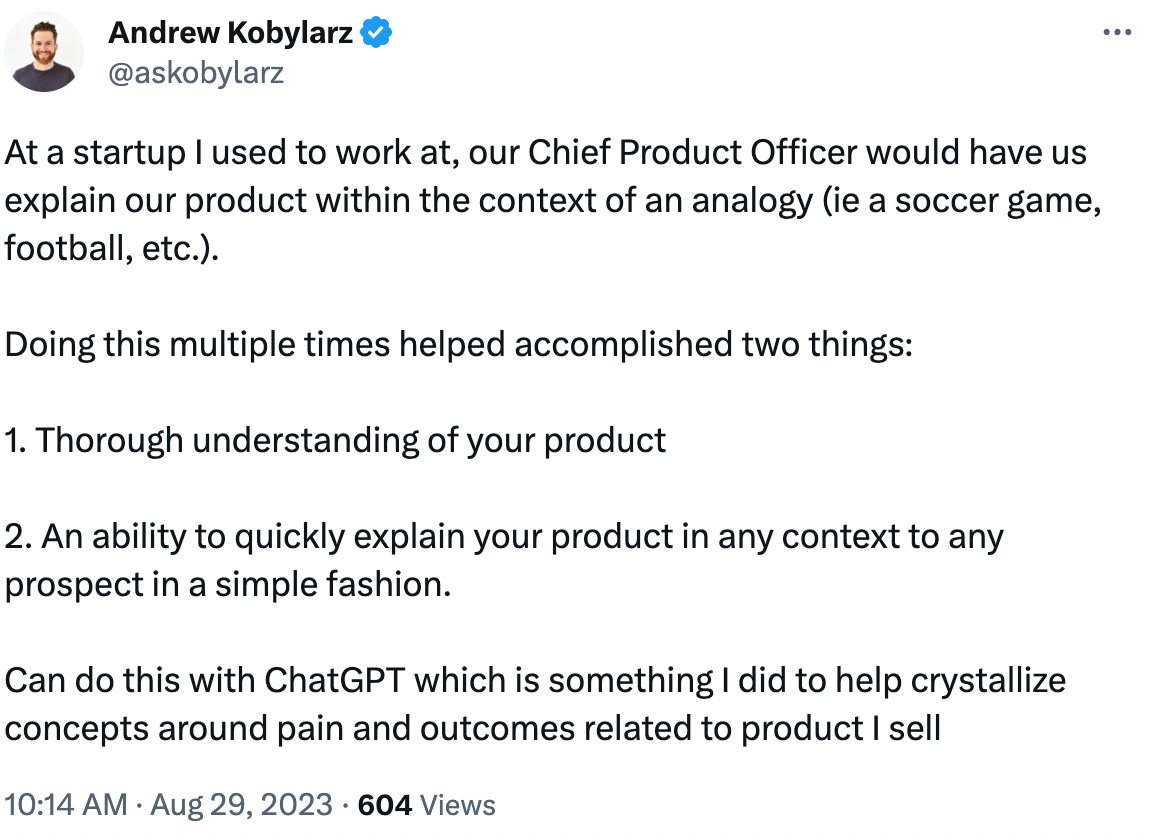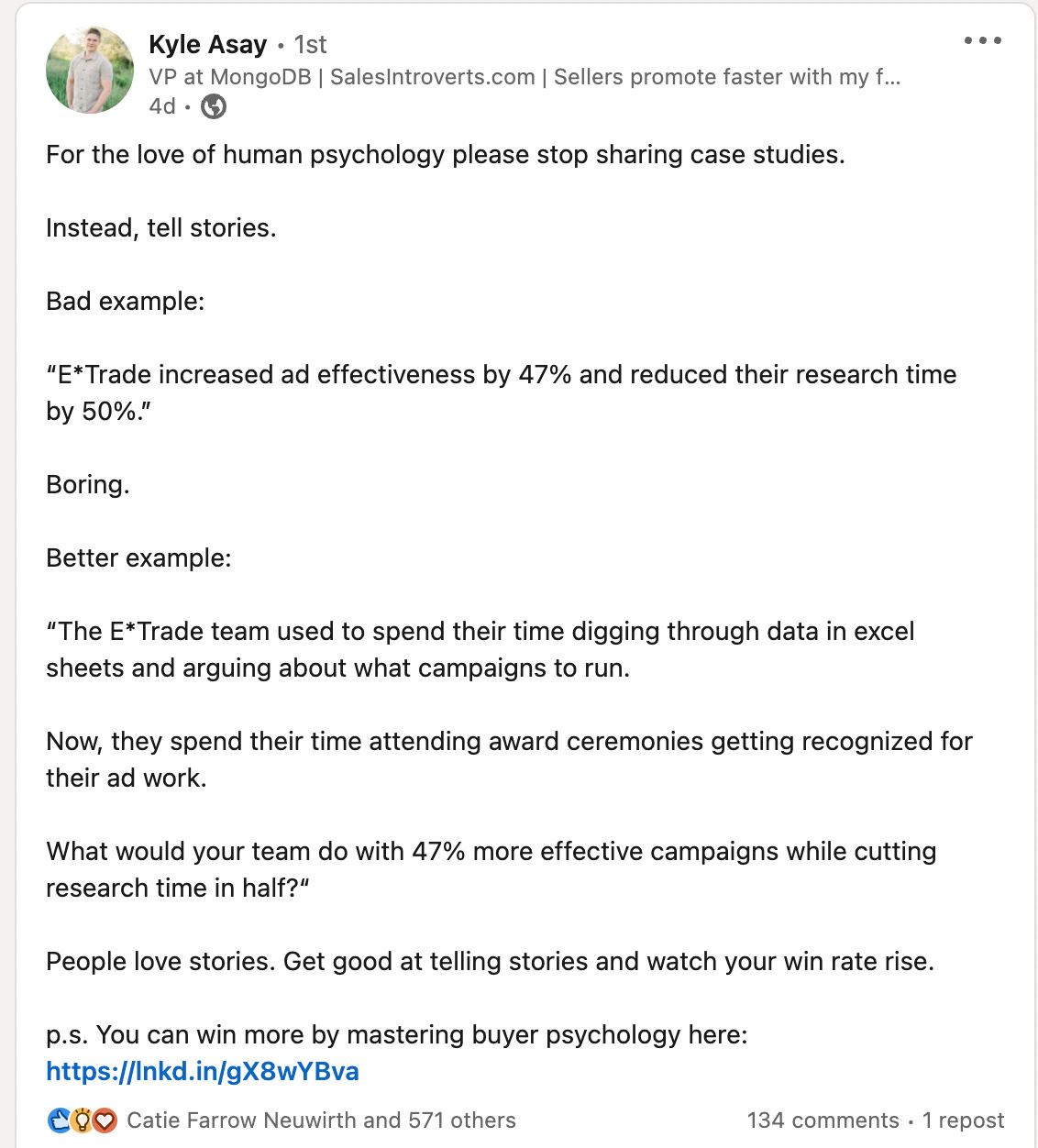Become a Master Storyteller
The two things you need to understand and qualify any prospect
“The bigger the picture, the larger the lens” - John McMahon
The key to sales communication isn’t presenting case studies and ROI. It’s sharing relatable stories. This is true when talking to C level executives all the way down to managers.
In order to do sharpen sales communication you need two things:
An ability to be simply explain your offering (note that I didn’t say product).
Be a master storyteller (notice that I didn’t say case studies)
Why?
Last week we talked about the key question that prospects with influence and money have - “Why should I stick my neck out?”
The only way to answer these questions is discovery. That and running a discovery call that doesn’t come across like an interrogation, is the ability to tell relatable stories. You need to be able to do this for any audience and dumb down what you have to offer in an extremely simple way.
This sounds like cliché advice. “If you can’t explain your business to a five year old, it’s too complicated.” Or whatever that quote is.
Not a lot of sellers take this to heart. We fall into the easy trap of talking to case studies, products, and can’t quickly get to a point where a prospects sees that you truly understand them. This is important because once you’ve established this, it becomes much easier for someone to tell you their problems.
Easier to say in a blog post and much harder in practice. So today I wanted to breakdown some ways to get you there.
Simply Explain Anything to Anyone
You need to be salient in how you talk to your audience and prospects. This means being able to dumb things down in not only a relatable way, but also an extremely simple way:
If you want to learn more about how to use ChatGPT to quickly crystallize both discovery questions and understand your offerings better, here’s another resource where I’ve covered these more in depth:
Learn New Concepts Faster with ChatGPT for Interviews and New Roles
Note that you can use Bard as well, it’s just a matter of playing around with prompts.
Doing all of this will give you the confidence to be able to tell a story and dumb it down to anyone. Saw this tweet and it rings extremely true:
Credit: Tech Sales Guy
Become a Master Storyteller
I recently had a conversation with one of our content leads who’s an absolute rockstar. We had a conversation around what the team needs for demos and sales enablement.
After exchanging a round of back and forth I realized, “We don’t need case studies, we need anecdotal customer stories”. We have great case studies with great brands.
But guess what?
Most companies don’t care that you did this transformational deal with this massive brand. At best, it’s credibility and proof points.
If a customer in your portfolio is in the F100 it’s not really relatable to the vast majority of new or even existing customers you sell to unless they are also in a similar category or an organization of similar size.
Think about it, if I’m a VP at a 300 person company doing $50mm in revenue - how is a F100 brand case study relatable? Why do I care? Great to have but not relatable.
Kyle Asay, VP at MongoDB nails this:
Credit: Kyle Asay
The easiest way to do this:
Ask your customers questions that don’t involve selling. Especially if you keep hearing consistent themes across your customer base.
I recently had a call with a customer where I heard, yet again, a certain challenge come up. I paused the conversation and simply asked, “I keep hearing xyz challenge across almost every single customer call - our product aside, what’s your perspective as to why this is a challenge?”
Amazing how quickly someone opens up when you don’t have a motive behind a question. It lets their guard down, they know you’re not selling. You’re trying to understand. This arms you with invaluable insight that you can use for other customers and you might even surface a challenge during that customer’s explanation.
Here’s another great example of how a simple question that has nothing to do with selling opens up the door to a deep understanding of a customer.
Credit: The Deal Director
(PS, if you’re on X, give a follow, solid sales advice and content from Deal Director)
Build up an arsenal of these relatable stories and watch how quickly you can operationalize your talk tracks. I did this at a former company, building out their healthcare vertical. I didn’t realize it then but getting that insight ended up being the fuel for intimately understanding almost every prospect I hopped on a call with. This lead to predictable sales revenue in that segment over the course of two years.
Remember that telling the story and being relatable is timeless. As humans, we’re WIRED for it. It might show up in different forms over the years, but the principle itself is tried, true, and timeless. With it, you’ll be a far better seller.
As always, thanks for reading and see you all next week.
-Andrew K
PS - if you’re looking to me to unpack a specific topic, or just want to connect - shoot a note over to andrew@hackingsales.xyz. If you want to chat, book some time here.





